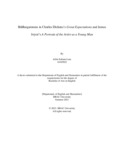| dc.contributor.advisor | Chowdhury, Rukhsana R. | |
| dc.contributor.author | Lata, Afrin Sultana | |
| dc.date.accessioned | 2023-01-18T08:34:46Z | |
| dc.date.available | 2023-01-18T08:34:46Z | |
| dc.date.copyright | 2021 | |
| dc.date.issued | 2021 | |
| dc.identifier.other | ID: 16103022 | |
| dc.identifier.uri | http://hdl.handle.net/10361/17756 | |
| dc.description | This thesis is submitted in partial fulfillment of the requirements for the degree of Bachelor of Arts in English, 2021. | en_US |
| dc.description | Cataloged from PDF version of thesis. | |
| dc.description | Includes bibliographical references (pages 67-70). | |
| dc.description.abstract | Bildungsroman novels also known as “coming- of- age” novels deal with subjectivity and the
relationship between the self and society. A bildungsroman novel mainly conveys the narrative
of a person's cognitive development within the perspective of a predetermined social structure. In
the narratives, the character's advancement is represented both as an employment to existence
and an investigation for reasonable life within the community.
Charles Dickens (1812-1870) and James Joyce (1882-1941) have used bildungsroman in their
novels, Great Expectations and A Portrait of an Artistas a Young Man, respectively this thesis
aims to focus on their different approaches. Since the novels are written in different periods, the
style, techniques and writing devices are also different. The main focus of the thesis is to analyse
the social as well as the psychological state of the protagonists. The bildungsroman traces the
social and psychological reality of the protagonists from childhood to adulthood. The settings,
characters and plots in these two novels are centered around society’s middle and lower classes.
In Great Expectations, we can see an uneven social class structure, contrast between rural and
urban England, immorality of the high class, flaw of the judicial system, uneven educational
opportunities and quality of the Victorian era. Pip’s journey of finding himself from childhood to
adulthood will critically be analised through the lens of social realism in this thesis. In addition,
A portrait of the Artist as a Young Man shows us the view of an Irish Catholic society, where
Stephen, in search of his life’s anchor, finally determines to turn away from priesthood towards
art. Stephen’s journey of finding himself from childhood to adulthood will be critically analyzed
through the lens of psychological realism in this thesis. Therefore, the main focus of this thesis will be to show how the selected bildungsroman novels
of Dickens and Joyce use realism and psychological realism to portray the life journey of Pip and
Stephen from childhood to adulthood. | en_US |
| dc.description.statementofresponsibility | Afrin Sultana Lata | |
| dc.format.extent | 70 Pages | |
| dc.language.iso | en_US | en_US |
| dc.publisher | Brac University | en_US |
| dc.rights | Brac University theses are protected by copyright. They may be viewed from this source for any purpose, but reproduction or distribution in any format is prohibited without written permission. | |
| dc.subject | Realism | en_US |
| dc.subject | Social realism | en_US |
| dc.subject | Psychological realism | en_US |
| dc.subject | Bildungsroman | en_US |
| dc.subject | Self-realisation | en_US |
| dc.subject | Self-identity | en_US |
| dc.subject.lcsh | Bildungsromans--History and criticism. | |
| dc.title | Bildungsroman in Charles Dickens’s Great Expectations and James Joyce’s A Portrait of the Artist as a Young Man | en_US |
| dc.type | Thesis | en_US |
| dc.contributor.department | Department of English and Humanities, Brac University | |
| dc.description.degree | B.A. in English | |

